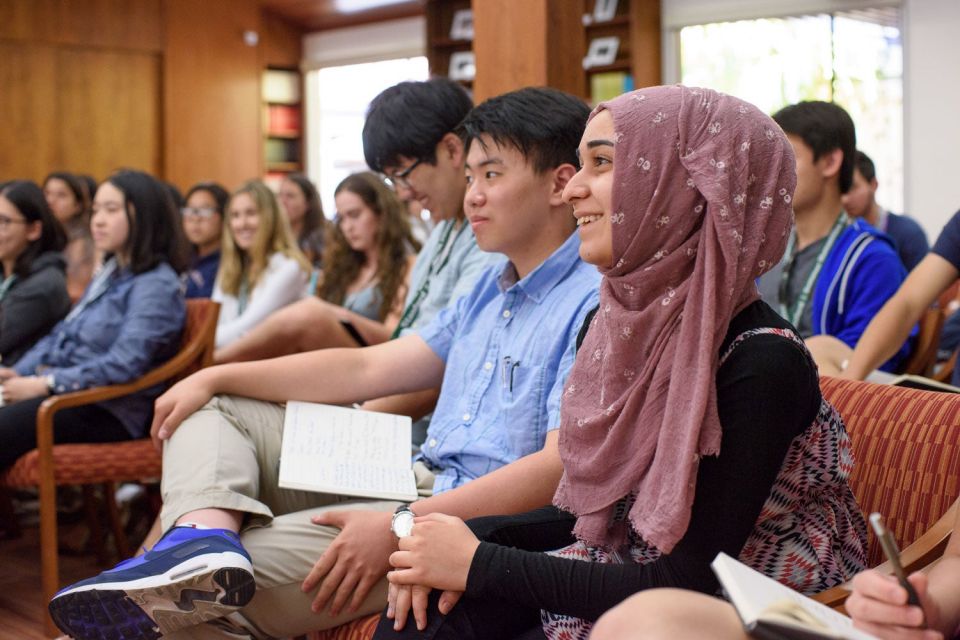Dressed in togas made of dormitory sheets and sporting paper laurels on their heads, two high school students participating in this year’s Stanford Summer Humanities Institute (SHI) walked to the front of a lecture room, waving hands in a regal manner.

High school student Feyza Yucel, right, and other students listen to professors during one of the lectures for a new Stanford Humanities Institute class Ancient Rome and Its Legacies. (Linda Cicero/Stanford News Service) (Image credit: L.A. Cicero)
“Today, we welcome Julius Caesar and Augustus,” said another student at the front of the room, initiating applause from the crowd.
In an eight-minute skit, the students reenacted a fictional segment of a Fox News program in which ancient Roman leader Julius Caesar and his adopted son, Emperor Augustus, give advice to President Donald Trump about governance.
“President Trump, you have done a great job at getting some of the people to love you, but in doing so, you’re actually dividing the country,” said the student portraying Julius Caesar. “If you truly want to make America great, you need to unite the nation under a common identity. It’s the stuff of the Romans’ genius – their ability to integrate the people they conquered.”
The skit was part of the final project for students who took the institute’s new class on ancient Rome. The institute offers a three-week intensive program for high school sophomores and juniors every summer. The program’s courses, taught by Stanford faculty, offer deep immersion in history, philosophy and literature, and expose students to the life of a humanities scholar.

Christopher Krebs, an associate professor of classics, talks about ancient Rome’s revolutions during a new class at the Stanford Humanities Institute. (Image credit: L.A. Cicero)
The new class, Ancient Rome and Its Legacies, examined the rise and fall of the influential civilization and how its legacies have shaped the European colonization of the Americas and the development of the United States. The class, co-taught by history Professor Caroline Winterer and Associate Professor of classics Christopher Krebs, compared similarities and differences between the worlds of ancient Rome and America.
Students attended lectures and question-and-answer sessions with professors, discussed reading materials in small groups with Stanford graduate students, examined Stanford University Libraries’ rich collection of early modern books about ancient Rome and spent an afternoon in the Cantor Arts Center exploring Roman artifacts and neoclassical painting and sculpture.
The idea for the class emerged, in part, because past SHI students expressed an interest in learning about classical antiquity, said Winterer, director of the Stanford Humanities Center.
“We wanted to offer a course that showed why the classical past is still so important for us to understand today,” Winterer said. “Ancient Rome isn’t dead – it’s alive and well and continues to shape the way we think about our world today, often in subtle ways that we don’t see unless we know how and where to look.”

History Professor Caroline Winterer, co-instructor for the class, is director of the Stanford Humanities Center. (Image credit: L.A. Cicero)
Many modern societies have borrowed some aspect of ancient Roman thought, but its shaping influence on the United States has been especially profound. The framers of the U.S. Constitution incorporated Roman ideas about the separation of powers and the need for a senate. The fluted white columns decorating the neoclassical facades of many antebellum American plantation mansions mimic those on Roman temples.
The class also focused on slavery, another similarity between ancient Rome and America. Both were slave societies, holding a significant proportion of their populations in legal bondage. “For most of human history, slavery was not seen as morally problematic,” Winterer said during the lecture on the rise of anti-slavery ideas in the United States before the Civil War. “That shift in human consciousness and understanding was so great that it’s difficult for us to put ourselves in a moment before that time.”
Elias Jinich, a high school senior in San Diego, said Krebs’ lectures on Rome were especially intriguing to him because of his interest in classical history and politics.
In between lectures and reading assignments, Jinich said he would spend his time discussing history with his classmates and resident counselors.
“It’s been a great congregation of like-minded students,” Jinich said. “As someone who is deeply passionate about history, I’m very happy to have experienced this.”
High school senior Feyza Yucel said she decided to take Winterer and Krebs’ class because she was curious to learn from a historian and a classicist at the same time.
“It was really interesting to focus on these two civilizations that are generally considered completely different,” Yucel said.
Yucel attended SHI for the second consecutive year. She credited the program’s dedicated staff and counselors as well as the Stanford faculty as the reason why she came back.
“It’s a great way to spend the summer,” she said.